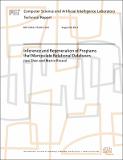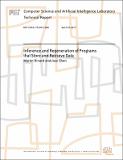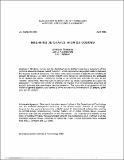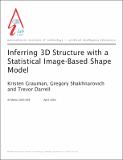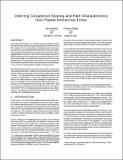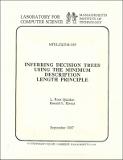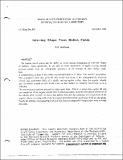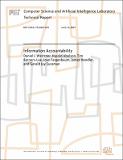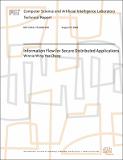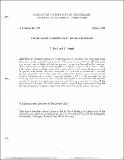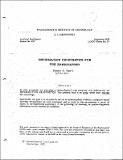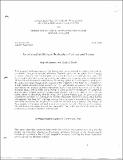Browsing Computer Science and Artificial Intelligence Lab (CSAIL) by Title
Now showing items 1628-1647 of 3804
-
Infants in Children Stories - Toward a Model of Natural Language Comprehension
(1972-08-01)How can we construct a program that will understand stories that children would understand? By understand we mean the ability to answer questions about the story. We are interested here with understanding natural ... -
Inference and Regeneration of Programs that Manipulate Relational Databases
(2017-08-29)We present a new technique that infers models of programs that manipulate relational databases. This technique generates test databases and input commands, runs the program, then observes the resulting outputs and updated ... -
Inference and Regeneration of Programs that Store and Retrieve Data
(2017-04-24)As modern computation platforms become increasingly complex, their programming interfaces are increasingly difficult to use. This complexity is especially inappropriate given the relatively simple core functionality that ... -
Inference of Generic Types in Java
(2003-03)Future versions of Java will include support for parametric polymorphism, or generic classes. This will bring many benefits to Java programmers, not least because current Java practise makes heavy use of pseudo-generic ... -
Inferring 3D Shapes from 2D Codons
(1985-04-01)All plane curves can be described at an abstract level by a sequence of five primitive elemental shapes, called "condons", which capture the sequential relations between the singular points of curvature. The condon ... -
Inferring 3D Structure with a Statistical Image-Based Shape Model
(2003-04-17)We present an image-based approach to infer 3D structure parameters using a probabilistic "shape+structure'' model. The 3D shape of a class of objects may be represented by sets of contours from silhouette views ... -
Inferring Decision Trees Using the Minimum Description Length Principle
(1987-09)We explore the use of Rissanen's Minimum Description Length Principle for the construction of decision trees. Empirical results comparing this approach to other methods are given. -
Inferring Shape from Motion Fields
(1980-12-01)The human visual system has the ability o utilize motion information to infer the shapes of surfaces. More specifically, we are able to derive descriptions of rigidly rotating smooth surfaces entirely from the orthographic ... -
Information Accountability
(2007-06-13)Ease of information flow is both the boon and the bane of large-scale, decentralized systems like the World Wide Web. For all the benefits and opportunities brought by the information revolution, with that same revolution ... -
Information Dissemination and Aggregation in Asset Markets with Simple Intelligent Traders
(1998-09-01)Various studies of asset markets have shown that traders are capable of learning and transmitting information through prices in many situations. In this paper we replace human traders with intelligent software agents ... -
Information Flow for Secure Distributed Applications
(2009-08-27)Private and confidential information is increasingly stored online and increasingly being exposed due to human errors as well as malicious attacks. Information leaks threaten confidentiality, lead to lawsuits, damage ... -
Information Processing and Transmission in Cellular Automata
(1971-01-01)A cellular automaton is an iterative array of very simple identical information processing machines called cells. Each cell can communicate with neighboring cells. At discrete moments of time the cells can change from ... -
Information Processing and Transmission in Cellular Automata
(1971-01)A cellular automaton is an iterative array of very simple identical information processing machines called cells. Each cell can communicate with neighboring cells. At discrete moments of time the cells can change from ... -
An Information Processing Approach to Understanding the Visual Cortex
(1980-04-01)An outline description is given of the experimental work on the visual acuity and hyperacuity of human beings. The very high resolution achieved in hyperacuity corresponds to a fraction of the spacing between adjacent ... -
Information Processing in Dendritic Spines
(1983-03-01)Dendritic spines are small twigs on the dendrites of a very large class of neurons in the central nervous system. There are between 10 (3) and 10 (5) spines per neuron, each one including at least one synapse, i.e. a ... -
Information Prosthetics for the Handicapped
(1978-09-01)In this proposal we describe a technological step towards the realization of INFORMATION PROSTHETICS. Our primary focus is on using rather than making the technology. Specifically, our goal is to transpose for the use ... -
Information Slicing: Anonymity Using Unreliable Overlays
(2007-02-23)This paper proposes a new approach to anonymous communication called information slicing. Typically, anonymizers use onion routing, where a message is encrypted in layers with the public keys of the nodes along the path. ... -
An Information Storage Mechanism: Calcium and Spines
(1984-04-01)This proposal addresses some of the biophysical events possibly underlying fast activity-dependent changes in synaptic efficiency. Dendritic spines in the cortex have attracted increased attention over the last years ...


